Automotive Robots: Revolutionizing the Assembly Line
Automotive robots are reshaping production processes, enhancing quality, and redefining the future of the automotive industry. Let’s discover how these mechanical marvels are driving innovation on factory floors worldwide.

Robot Assembly Line in Car Factory
Introduction
Automotive robots are reshaping the automotive industry, serving as the backbone of modern assembly lines. These advanced systems, characterized by precision and speed, are integral to enhancing production efficiency and product quality. From welding and painting to assembly and quality control, automotive robots execute tasks with unparalleled consistency, reducing errors and optimizing output.
Beyond automation, automotive robots drive innovation, enabling the creation of increasingly complex and sophisticated vehicles. As automotive manufacturers integrate diverse robotic automation solutions, production lines are evolving into intelligent, flexible ecosystems. This transformation not only boosts productivity and cost-effectiveness but also empowers human workers to focus on higher-level tasks, ultimately reshaping the landscape of automotive manufacturing for the 21st century.
The Mechanical Workforce: Understanding Automotive Robots
What are Automotive Robots?
Automotive robots are highly specialized industrial robots designed to perform a variety of tasks within the automotive manufacturing process. They are intricate systems comprising mechanical, electrical, and computer components, all working together to achieve precise and efficient operations. These robots have been instrumental in transforming the automotive industry, enhancing productivity, quality, and safety.
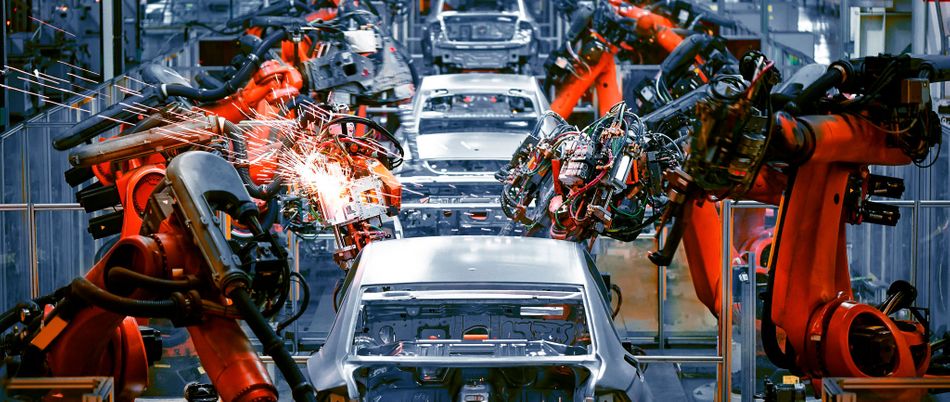
To understand automotive robots, it's essential to trace their origins. The concept of automated machines can be traced back to ancient civilizations, with devices like water clocks and windmills demonstrating early principles of automation. However, the foundation for modern industrial robots was laid in the mid-20th century.
The term "robot" was coined by Czech playwright Karel Čapek in his 1920 play "R.U.R." (Rossum's Universal Robots), although the concept of artificial servants had been explored in literature and mythology for centuries. [1] Early industrial robots were primarily large, hydraulically powered machines with limited capabilities. In the early 20th century, George Devol invented the first programmable industrial robot. However, it was the post-World War II era that witnessed significant advancements in robotics, driven by the need for automation in manufacturing.
General Motors made a groundbreaking move in 1961 by deploying prototype industrial robots for spot welding. This successful experiment caught the attention of Ford and other industry giants. A quantum leap occurred in 1969 with the development of the Stanford Arm. Equipped with six degrees of freedom, it surpassed the capabilities of previous robots. Building on this success, the MIT-developed Silver Arm, introduced in 1974, incorporated pressure-sensitive sensors and a microprocessor, dramatically expanding robotic capabilities. This era marked the beginning of a rapid growth phase for robotics, with annual growth rates exceeding 30%. [2]
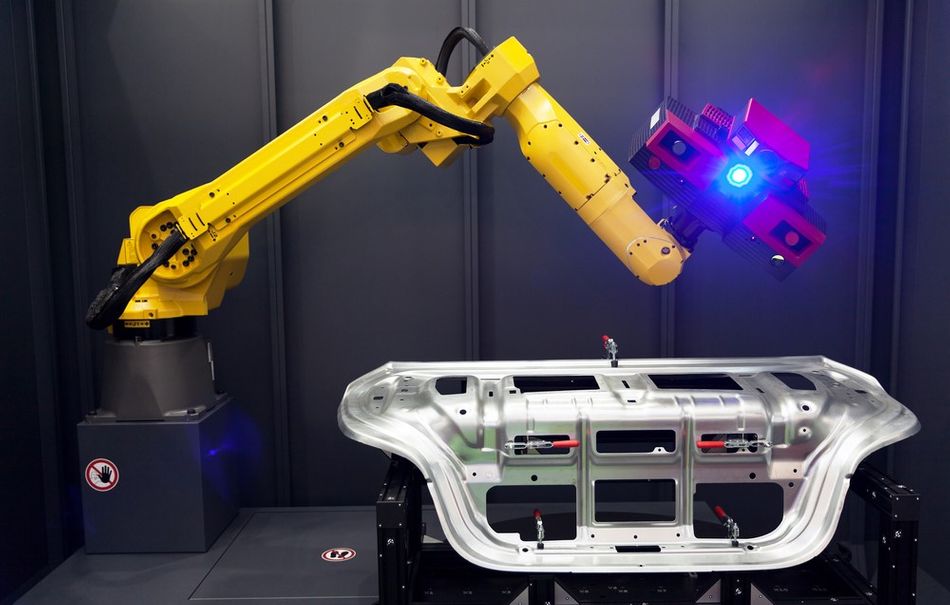
By the 1980s, billions of dollars were invested globally to automate basic assembly line tasks. While the pace of automation slowed in the 1990s, the industry experienced a resurgence driven by continuous technological breakthroughs.
Today, automotive robots are known for their precision and repeatability. They can perform tasks with a level of accuracy and consistency that is unattainable by human workers. This precision is critical in automotive manufacturing, where even minor imperfections can lead to product defects.
Furthermore, automotive robots are designed to operate in demanding industrial environments. They are built to withstand heavy loads, vibrations, and exposure to harsh chemicals. This durability ensures their reliability and longevity in the demanding automotive production process.
Recommended Reading: Robots in the Manufacturing Industry: Types and Applications
Types of Automotive Robots
The automotive industry employs a diverse range of robots to optimize production processes, each designed to excel in specific tasks within the manufacturing process. These robots have revolutionized car production, enhancing efficiency, precision, and safety on assembly lines worldwide.
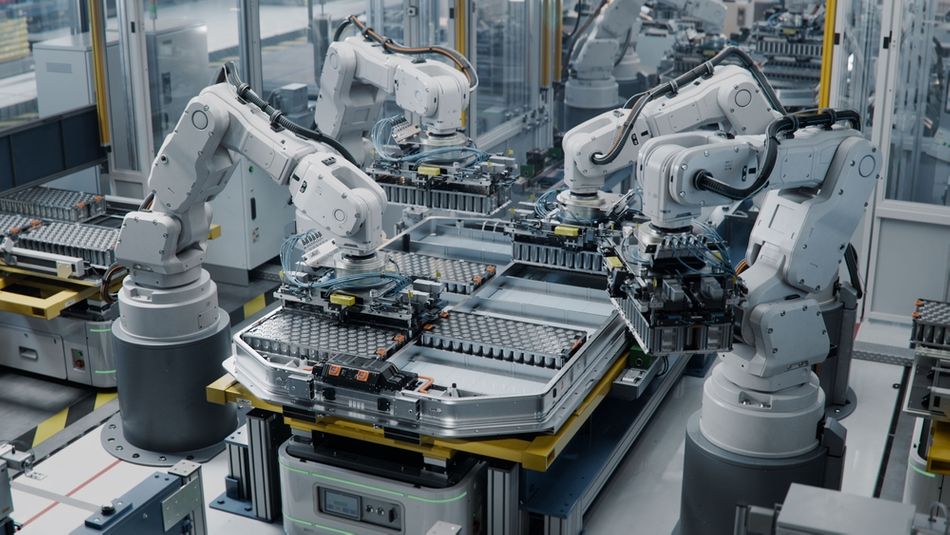
Articulated Robots are the most common type in automotive manufacturing. These versatile machines mimic the human arm with multiple joints, offering exceptional flexibility and reach. With typically 4-6 axes of motion, articulated robots excel in tasks requiring complex movements, such as welding, painting, and assembly. [3] Their adaptability makes them ideal for various applications across the production line.
SCARA (Selective Compliance Assembly Robot Arm) robots are known for their speed and precision in pick-and-place operations. With a cylindrical work envelope, these robots move quickly in the horizontal plane while maintaining rigidity in the vertical direction. They are commonly used in assembly processes, such as installing components on dashboards or assembling small parts. SCARA robots offer a good balance of speed, accuracy, and affordability.
Collaborative Robots, or cobots, are designed to work safely alongside humans, cobots are increasingly popular in automotive assembly. They are smaller, lighter, and more user-friendly than traditional industrial robots. These robots are increasingly used in automotive manufacturing for tasks that benefit from human-robot collaboration, such as final assembly, quality inspection, and physically demanding operations.
Delta Robots, characterized by their unique parallel link structure, excel in light-duty applications due to their exceptional speed and accuracy. With their unique parallel structure, delta robots excel at high-speed pick-and-place operations. They are widely used in automotive assembly for tasks like part feeding, packaging, and machine tending. Their fast cycle times and precision make them suitable for high-volume production.
Cartesian Robots, also known as gantry robots, operate on a three-axis linear motion system. Their simple, scalable design makes them ideal for large work envelopes and heavy payload applications. In automotive plants, cartesian robots are often employed for material handling, palletizing, and large component assembly. Their rigid structure ensures high accuracy and repeatability.
Cylindrical Robots feature a rotary joint at the base and prismatic joints for vertical and radial movement. Their cylindrical work envelope makes them suitable for machine tending, assembly, and handling operations within confined spaces.
Let’s understand their basic differences:
| Robot Type | Key Features | Primary Applications | Payload Capacity |
| Articulated | 4-6 Axis Flexible Movement | Welding, Painting, Assembly | 3-1000+ kg |
| SCARA | Fast, Precise Horizontal Movement | Pick and Place, Small Assembly | 1-20 kg |
| Delta | High Speed, Parallel Kinematics | High-Speed Picking, Packaging | 0.5-8 kg |
| Cartesian | Large Work Envelope, Scalable | Material Handling, Large Assembly | 2-500+ kg |
| Collaborative | Safe Human Interaction, Easy Programming | Final Assembly, Quality Inspection | 4-50 kg |
| Cylindrical | Rotary Base, Vertical/Radial Movement | Machine Tending, Confined Space Operations | 2-300 kg |
Each type of automotive robot contributes to the overall efficiency and productivity of the assembly line. The choice of robot depends on factors such as the specific task requirements, payload, speed, precision needs, and the available workspace. By selecting the appropriate robot for specific tasks, automotive manufacturers can optimize their operations and achieve higher levels of quality and output.
Recommended Reading: 7 Types of Industrial Robots: Advantages, Disadvantages, Applications, and More
Key Components and Technologies
Automotive robots are complex systems comprised of several essential components working together to perform intricate tasks with precision and efficiency. The core elements of these robotic systems include actuators, sensors, and controllers, each playing a crucial role in the robot's functionality.
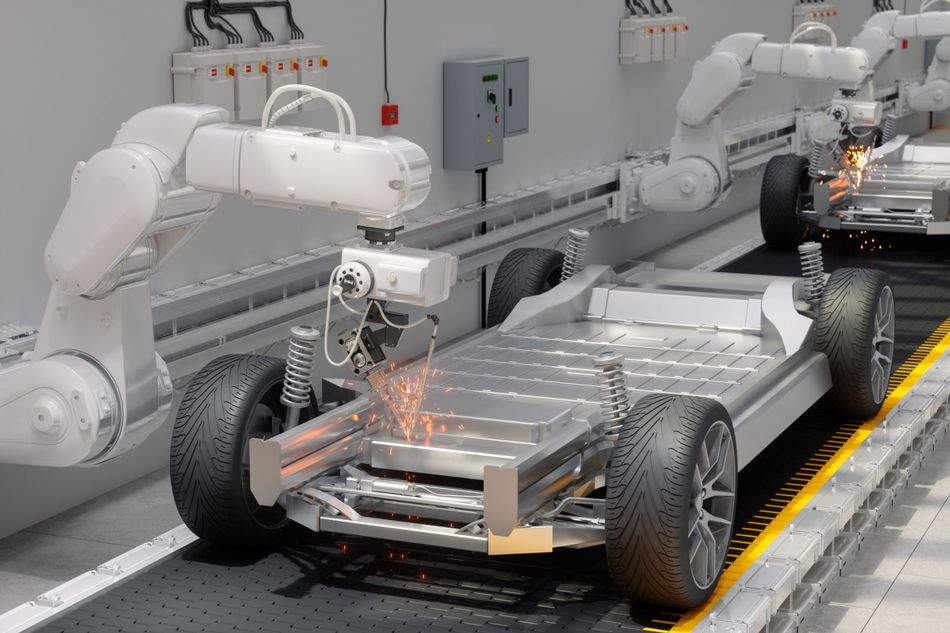
Actuators are the 'muscles' of the robot, responsible for converting energy into mechanical motion. In automotive robots, these often take the form of electric motors, hydraulic cylinders, or pneumatic systems. Electric motors, such as servo motors, are widely used due to their precise control and efficiency. They enable the robot to perform movements ranging from large-scale positioning to fine, detailed manipulations required in assembly tasks.
Sensors act as the robot's 'senses,' providing crucial feedback about the robot's environment and its own state. These include force sensors for detecting contact and pressure, vision sensors for object recognition and positioning, and proprioceptive sensors that monitor the robot's internal state (e.g., joint positions, and velocities). Advanced automotive robots often employ a combination of sensor types to ensure accurate and safe operation in dynamic manufacturing environments.
Controllers serve as the 'brain' of the robotic system, processing sensor data and coordinating the robot's actions. These sophisticated computers run complex algorithms to interpret sensor inputs, make decisions, and control the actuators to execute desired movements. Modern controllers in automotive robots often incorporate real-time processing capabilities to handle the high-speed, precise operations required in manufacturing.

The integration of advanced technologies has significantly enhanced the capabilities of automotive robots. Artificial Intelligence (AI) and Machine Learning algorithms enable robots to adapt to variations in their tasks and environment, improving flexibility and reducing the need for constant reprogramming. For instance, AI-powered robots can optimize their movements based on experience, leading to increased efficiency over time.
Computer Vision technology has revolutionized quality control and object manipulation in automotive manufacturing. By processing and analyzing visual data in real time, robots can identify defects, guide precise assembly operations, and navigate complex environments with greater autonomy.
Emerging technologies in the field of automotive robotics include:
Collaborative AI: Enabling multiple robots to work together seamlessly, sharing tasks and information
Advanced Materials: Development of lighter, stronger materials for robot construction, improving speed and energy efficiency
Haptic Feedback Systems: Providing robots with a sense of touch for more delicate operations
Edge Computing: Processing data closer to the source for faster response times and reduced latency
Digital Twins: Creating virtual replicas of robots and production lines for simulation and optimization
5G Integration: Leveraging high-speed, low-latency networks for improved robot communication and control
Soft Robotics: Incorporating flexible and adaptable components for safer human-robot interaction
These emerging technologies are pushing the boundaries of what's possible in automotive manufacturing, promising even greater levels of efficiency, flexibility, and innovation in the future. By effectively combining these components and technologies, automotive robots have become indispensable in modern manufacturing, enhancing productivity, quality, and safety.
Recommended Reading: Industry 4.0 Deep Dive: Evolving Industrial Robots
Automotive Robots in Action: Applications and Processes
Assembly Line Integration
The integration of robots into automotive assembly lines represents a significant leap in manufacturing efficiency and precision. Modern car production facilities seamlessly blend robotic systems with traditional manufacturing processes, creating a highly optimized and flexible production environment. This integration occurs at various stages of the assembly line, from body shop operations to final assembly.

In the body shop, robots are typically arranged in cells or zones, each dedicated to specific tasks such as spot welding, sealing, or material handling. These robots work in coordination, passing partially assembled car bodies from one station to the next. Advanced sensor systems and real-time communication networks ensure precise positioning and timing, allowing multiple robots to work on a single car body simultaneously without interference. [4]
As the assembly process progresses, robots are strategically placed alongside human workers, each handling tasks best suited to their capabilities. For instance, robots might perform heavy lifting or repetitive tasks like applying adhesives or installing large components, while human workers focus on complex assembly operations that require agility and decision-making.
Collaborative robots represent a significant advancement in assembly line integration. These robots are designed to work safely alongside human operators without the need for safety fencing or segregation. Cobots are equipped with advanced sensors and force-limiting technology, allowing them to detect unexpected contact and stop immediately, ensuring worker safety. This collaboration between humans and robots combines the strength and precision of machines with the flexibility and problem-solving skills of human workers.
In practice, cobots might assist human workers by holding parts in place, providing tools, or performing simple repetitive tasks while the human focuses on more complex assembly operations. For example, a cobot might apply a bead of sealant around a windshield while a human worker ensures proper alignment and fitment.
Throughout the car production process, robots perform a wide array of specific tasks. In the paint shop, robotic arms equipped with paint sprayers apply even coats of paint and clear coats with a level of consistency impossible to achieve manually. In the powertrain assembly area, robots might install engines or transmissions into vehicle chassis with precision, ensuring proper alignment and torque specifications are met.
During final assembly, robots often handle tasks such as applying adhesives for windshield installation, mounting wheels, or installing seats. These operations require a high degree of accuracy and repeatability, which robots excel at. Additionally, robotic vision systems are employed for quality control, inspecting assembled components for defects or misalignments.
The integration of robots into automotive assembly lines has not only increased production efficiency but also improved product quality and worker safety. By carefully implementing effective integration strategies, automotive manufacturers can harness the full potential of robotic automation to drive operational excellence and competitiveness.
Recommended Reading: What are Robotic Assembly Lines? History, Components, Advantages, Limitations, Applications, and Future
Precision Engineering: Welding and Painting
Robotic welding and painting have revolutionized the automotive manufacturing industry, offering unparalleled precision, consistency, and efficiency. In welding processes, robots equipped with specialized welding guns perform tasks such as spot welding, arc welding, and laser welding. These robots can execute complex welding patterns with micron-level accuracy, ensuring strong and reliable joints in vehicle frames and body panels.
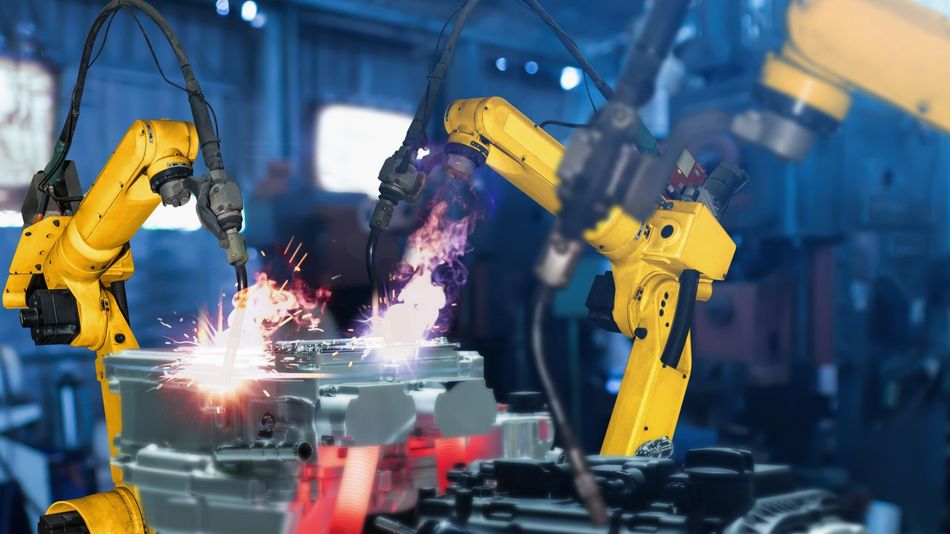
The advantages of robotic welding over manual methods are significant. Robots can maintain consistent weld quality over extended periods, eliminating variations caused by human fatigue. They can also access hard-to-reach areas of a vehicle chassis, performing welds that would be challenging or impossible for human welders. Moreover, robotic welding systems can operate continuously, dramatically increasing production throughput.
Technically, robotic welding systems employ sophisticated control mechanisms to ensure precision. For instance, in resistance spot welding, robots use precise force control and timing to create consistent weld nuggets. [5] In arc welding applications, robots utilize advanced seam tracking technologies, such as laser sensors or through-arc tracking, to adjust their path in real time, compensating for part variations or thermal distortion. Similarly, spot welding is used for joining sheet metal components, particularly in body-in-white construction.
Painting robots have similarly transformed automotive finishing processes. These robots use highly articulated arms with multiple degrees of freedom, allowing them to navigate complex vehicle contours. Advanced paint application techniques, such as electrostatic painting, are commonly employed. In this method, paint particles are electrically charged as they leave the spray gun, creating an electrostatic field that attracts the paint to the vehicle's surface. This results in improved transfer efficiency and reduced overspray.
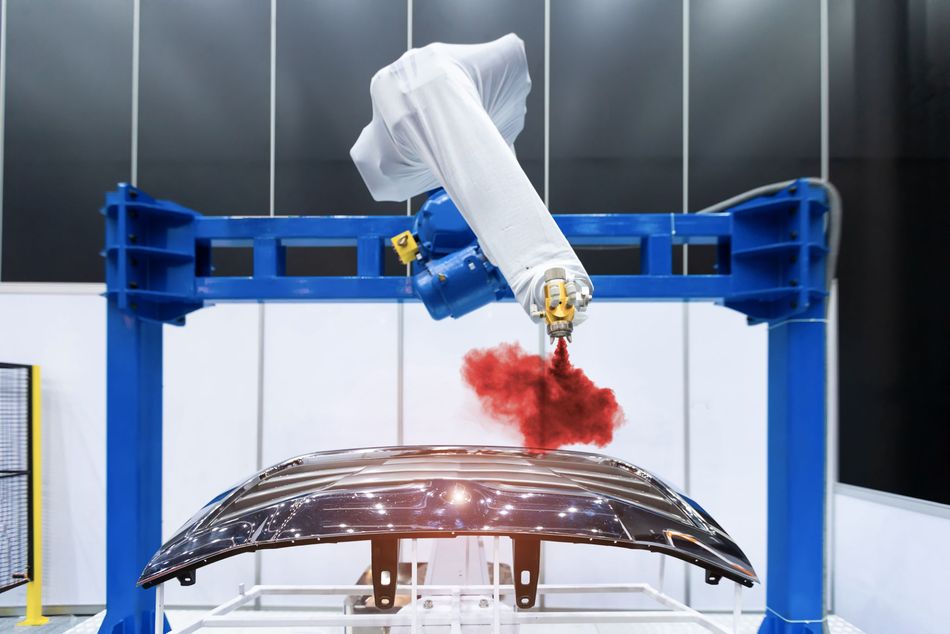
The advantages of robotic painting include superior consistency in paint thickness and coverage, which is crucial for both aesthetics and corrosion protection. Robots can maintain optimal spray gun distance and angle throughout the painting process, ensuring even application across all surfaces. They can also execute precise colour changes and apply multiple layers with minimal time between coats, enhancing productivity.
Robotic painting systems often incorporate advanced techniques like multi-axis movement, where robots move along rails or rotate on additional axes to reach all areas of the vehicle. Some systems use multiple robots working in coordination, with each robot responsible for specific sections of the vehicle. This approach optimizes paint coverage and minimizes cycle times.
Furthermore, robotic painting systems are increasingly integrating artificial intelligence and machine learning algorithms. These technologies enable real-time adjustments to painting parameters based on environmental conditions, ensuring consistent quality regardless of external factors. Some advanced systems even use computer vision to inspect the paint finish in real-time, allowing for immediate corrections or real-time.
Both welding and painting robots in automotive manufacturing are continuously evolving, with improvements in sensor technology, control systems, and AI driving ever-greater levels of precision and efficiency. As these technologies advance, they promise to further enhance the quality, consistency, and cost-effectiveness of automotive production processes.
Quality Control and Inspection
In automotive manufacturing, robots play a crucial role in quality control and inspection processes, ensuring consistent product quality and reducing the risk of defects reaching end-users. These robotic systems are integrated throughout the production line, from component manufacturing to final assembly, providing real-time monitoring and analysis of product quality.
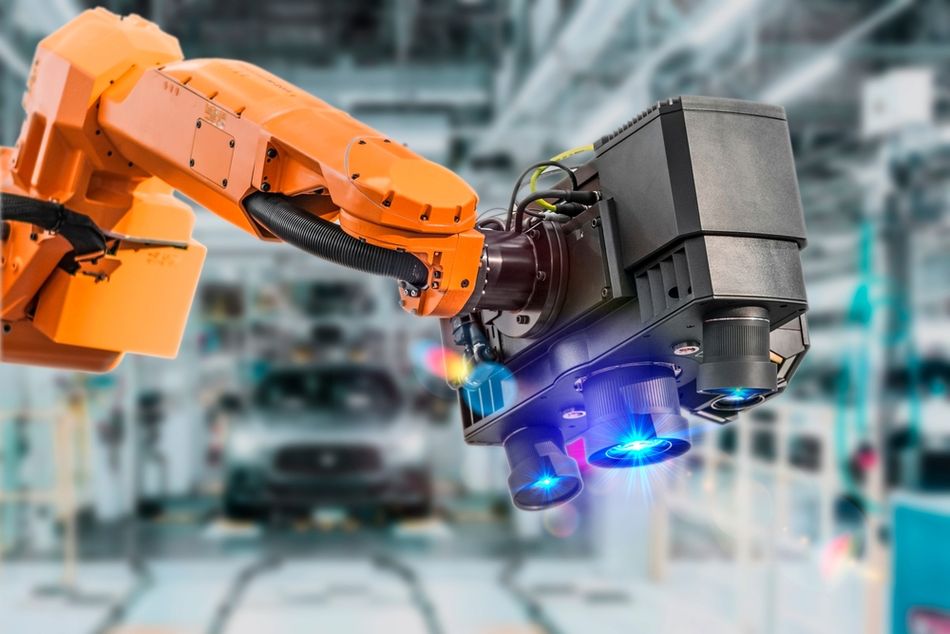
Robotic quality control systems in automotive manufacturing utilize a variety of advanced sensors and vision systems. High-resolution cameras equipped with machine vision software are commonly employed to capture detailed images of components and assemblies. These systems can detect minute visual defects that might be overlooked by human inspectors. Laser scanners are used for precise dimensional measurements, ensuring parts meet exact specifications. Infrared sensors can detect heat anomalies that might indicate welding defects or electrical issues.
One of the most sophisticated technologies in this field is 3D optical scanning. Using structured light technology, these systems can create highly detailed 3D models of components, allowing for comprehensive geometric analysis. This technology is particularly useful for complex automotive parts where traditional measurement methods might fall short.
CNC machines play a pivotal role in creating the intricate components that form the backbone of vehicles. These computer-controlled tools remove material with unparalleled accuracy, ensuring the production of parts that meet stringent quality standards. Automotive robots and CNC machines are interconnected within the broader supply chain. CNC-machined parts form the raw materials for assembly lines where robots take over. This seamless integration optimizes production flow, reduces lead times, and minimizes errors.
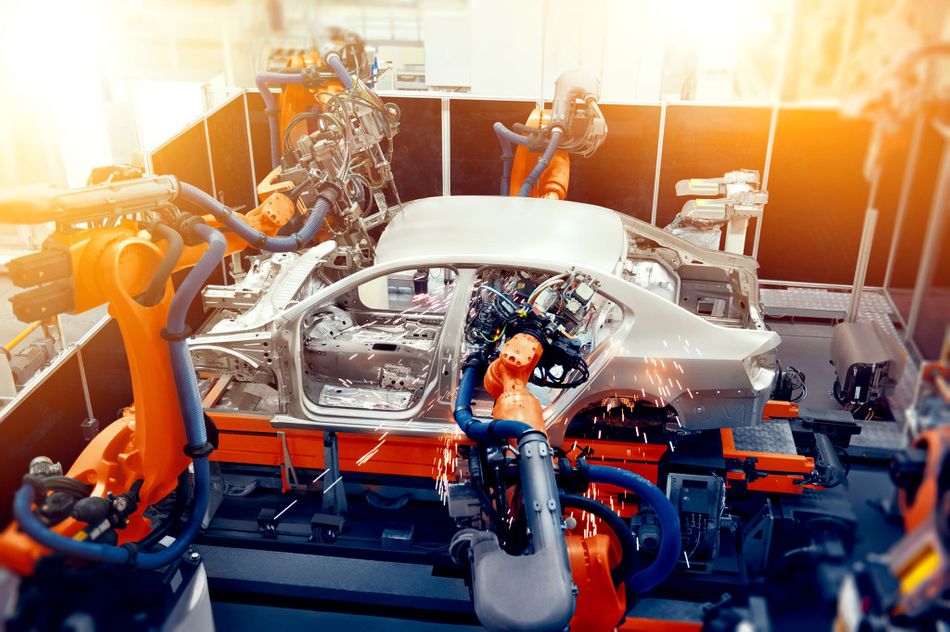
Robotic inspection systems can detect a wide range of defects in automotive manufacturing. For example, in welding processes, robots can identify issues such as porosity, incomplete fusion, or excessive spatter. In paint shops, they can detect inconsistencies in paint thickness, orange peel effects, or dust particles in the finish. During assembly, robots can check for missing components, incorrect positioning, or improper fastening. In electronics manufacturing, these systems can identify solder defects, component misalignments, or incorrect polarity in electrical connections.
The benefits of robotic quality control over manual inspection in automotive manufacturing are numerous:
Consistency: Robots maintain the same level of accuracy throughout long production runs, eliminating variations due to human fatigue.
Speed: Robotic systems can perform inspections much faster than human inspectors, keeping pace with high-speed production lines.
Precision: Advanced sensors and vision systems can detect defects at a microscopic level, surpassing human visual capabilities.
Data Collection: Robotic systems can automatically log inspection data, facilitating trend analysis and process improvement.
100% Inspection: Unlike manual sampling methods, robots can inspect every single product, reducing the risk of defective parts reaching customers.
Objectivity: Robotic systems eliminate subjective judgments, ensuring consistent quality standards.
Cost Effectiveness: While initial investment may be high, robotic systems can reduce long-term quality control costs and minimize waste from defective products.
Flexibility: Modern robotic inspection systems can be reprogrammed to accommodate new product designs or quality criteria.
By leveraging the power of robotics and advanced technologies, automotive manufacturers can achieve unprecedented levels of quality control, resulting in products that exceed customer expectations.
The Impact of Automotive Robots on Manufacturing
Efficiency and Productivity Gains
One of the key advantages of robotic systems is their ability to work continuously without fatigue. Unlike human workers who require breaks and shift changes, robots can operate 24/7, significantly increasing production output. This continuous operation, combined with the robots' high-speed performance, has led to substantial reductions in cycle times across various manufacturing processes.
Statistical data demonstrates the significant impact of robotics on production rates. The automotive industry has the largest number of robots working in factories around the world — operational stock hit a new record of about one million units, according to the International Federation of Robotics (IFR). Industrial companies plan to invest 25% of their capital in industrial automation over the next five years. Furthermore, research from the Boston Consulting Group indicates that the use of robots in manufacturing can lead to a 10% to 30% reduction in overall production costs. [6]
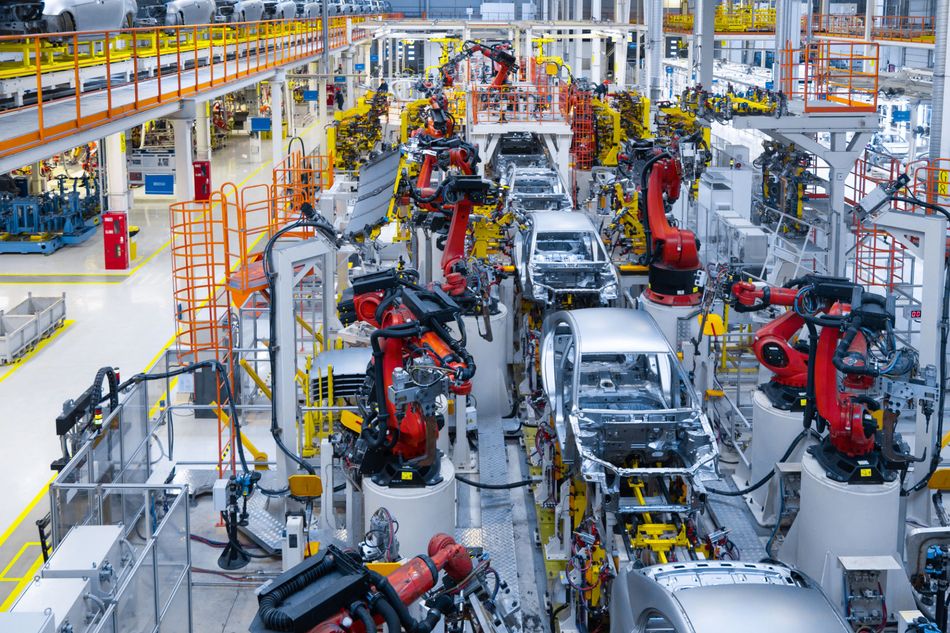
Real-world examples and case studies from leading automakers further underscore these efficiency gains. For instance, The BMW Spartanburg plant in South Carolina reported a massive increase in production capacity after introducing robotic systems in their body shop. The plant now produces over 1,500 vehicles per day, and exports 60 percent of its vehicles.
Known for its innovative approach to manufacturing, Tesla has heavily invested in robotics. Their Fremont factory in California has leveraged advanced robotics to achieve remarkable production speeds. Their Model 3 production line can assemble a car body in as little as 45 seconds, a process that would take significantly longer with manual labor alone.
The Volkswagen Zwickau plant in Germany utilizes over 1,700 robots across its body shop and assembly lines. This extensive automation has enabled the plant to produce up to 1,350 to 1,500 vehicles per day, marking a substantial increase from its previous capacity.
These efficiency improvements extend beyond just speed and volume. Robotic systems have also contributed to enhanced quality control, reduced material waste, and improved energy efficiency in manufacturing processes. For example, robotic welding systems at the Ford Kentucky Truck Plant have improved weld quality while reducing energy consumption by 25% compared to previous methods.
The integration of collaborative robots has further enhanced productivity by allowing humans and robots to work side by side safely. This synergy combines the precision and strength of robots with the problem-solving skills and flexibility of human workers, leading to optimized production workflows.
Recommended Reading: Why Industrial Robotics is Experiencing Steady Growth
Quality and Consistency Improvements
Robotic systems have revolutionized quality control and consistency in automotive manufacturing, setting new standards for precision and reliability. By leveraging advanced sensors, vision systems, and AI-driven algorithms, robots perform intricate quality checks with unparalleled accuracy, far surpassing human capabilities in detecting even microscopic defects.
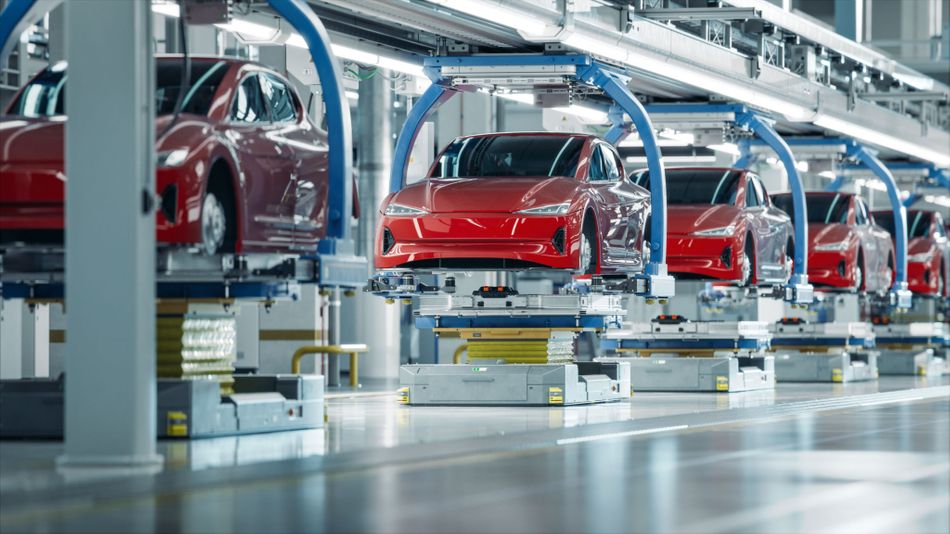
The implementation of robotics significantly reduces human error and variability in the production process. Unlike human workers who may experience fatigue or lapses in concentration, robots maintain consistent performance throughout extended production runs. This consistency is crucial in tasks such as welding, where robots can execute hundreds of welds with exact precision, ensuring uniform strength and appearance across all vehicle bodies.
Specific quality improvements achieved through manufacturing robots are evident across various aspects of car production. In paint shops, robotic systems apply coatings with uniform thickness and coverage, eliminating issues like the orange peel effect or uneven application that can occur with manual painting. Advanced vision systems integrated into robotic inspection stations can detect minute flaws in body panels, ensuring that only flawless components proceed to final assembly.
In the realm of assembly, robots equipped with force-feedback sensors can perform tasks like screw tightening with exact torque specifications. This eliminates the risk of over or under-tightening that can lead to component failures. Similarly, in electronics installation, robots can place and solder components with micron-level accuracy, significantly reducing the likelihood of connection failures or short circuits.
Key quality metrics that have been positively impacted by robotics include:
Defect Rates: Dramatic reduction in overall defect rates, with some manufacturers reporting up to a 75% decrease
Dimensional Accuracy: Improved consistency in component fitment and body panel alignment
Surface Finish Quality: Enhanced paint finish consistency and reduced imperfections
Weld Integrity: Increased strength and uniformity of welded joints
Assembly Precision: Improved accuracy in component placement and fastening
First-Time-Through (FTT) Rates: Significant increase in vehicles passing quality checks on the first attempt
Customer Satisfaction Scores: Higher ratings due to improved build quality and reliability
The integration of robotics in quality control has not only improved the end product but has also streamlined the entire manufacturing process. By detecting and addressing issues early in the production cycle, robotic systems help reduce waste, minimize rework, and lower overall production costs. This proactive approach to quality management has enabled automotive manufacturers to achieve higher standards of excellence while simultaneously increasing efficiency and productivity.
Recommended Reading: Overcoming Challenges in Industrial Robotics
Conclusion
Automotive robotics has fundamentally reshaped the automotive industry, propelling it into an era of unparalleled efficiency, precision, and quality. By automating repetitive and hazardous tasks, robots have liberated human workers to focus on higher-value activities, maintaining a collaborative human-machine partnership. This synergy has not only accelerated production but also elevated product quality to new heights.
As robotic technology continues to advance, the automotive industry stands at the forefront of a new era marked by intelligent, adaptive, and environmentally conscious processes. The success of this transformation hinges on a delicate balance between technological innovation and human ingenuity. By embracing this symbiotic relationship, the automotive sector can continue to lead the charge in global manufacturing and deliver exceptional products that exceed customer expectations.
Frequently Asked Questions
Q: What are the main types of robots used in automotive manufacturing?
A: The main types include articulated robots for tasks like welding and painting, SCARA robots for assembly, delta robots for high-speed picking, and collaborative robots (cobots) for working alongside humans. Each type is designed for specific tasks in the production process.
Q: How do automotive robots improve efficiency in car manufacturing?
A: Automotive robots improve efficiency by working continuously without fatigue, performing tasks faster and more precisely than humans, reducing cycle times, and minimizing errors. This leads to increased production rates and reduced manufacturing costs.
Q: What are the key benefits of using robots in automotive quality control?
A: Robots in quality control offer benefits such as consistent inspection standards, the ability to detect microscopic defects, 100% inspection coverage, real-time data collection for process improvement, and reduced human error in the inspection process.
Q: Are there any challenges in implementing robotic systems in automotive manufacturing?
A: Yes, challenges include high initial investment costs, the need for specialized programming and maintenance skills, potential job displacement concerns, and the complexity of integrating robotic systems with existing manufacturing processes.
Q: What future developments can we expect in automotive robotics?
A: Future developments may include more advanced AI and machine learning integration, improved human-robot collaboration, greater flexibility in robotic systems to handle product variations, and the use of robots in new areas of manufacturing such as battery production for electric vehicles.
References
[1] NDL Ethiopia. Robotics: A Reference Guide to the New Technology [Cited 2024 July 23] Available at: Link
[2] Automate. The History of Robotics in the Automotive Industry [Cited 2024 July 23] Available at: Link
[3] Wevolver. What are Articulated Robots? [Cited 2024 July 23] Available at: Link
[4] NCBI. Robotics Perception and Control: Key Technologies and Applications [Cited 2024 July 23] Available at: Link
[5] StandardBots. How to get started with robotic spot welding in 2024 [Cited 2024 July 23] Available at: Link
[6] The Robot Report. How Robots Boost Productivity, Quality, and Safety [Cited 2024 July 23] Available at: Link
Table of Contents
IntroductionThe Mechanical Workforce: Understanding Automotive RobotsWhat are Automotive Robots?Types of Automotive RobotsKey Components and TechnologiesAutomotive Robots in Action: Applications and ProcessesAssembly Line IntegrationPrecision Engineering: Welding and PaintingQuality Control and InspectionThe Impact of Automotive Robots on ManufacturingEfficiency and Productivity GainsQuality and Consistency ImprovementsConclusionFrequently Asked QuestionsReferences